Family name: Brassicaceae Burnett or Cruciferae Jussieu
Synonym(s): Raphanaceae Horan.; Stanleyaceae Nutt.; Thlaspiaceae Martinov
Common name(s): mustard family
*Number of genera/species: 332/3,628
List of genera records in GRIN-Global
Fruit usually a bivalved capsulecapsule:
a dry, dehiscent fruit derived from a compound ovary (commonly called a siliquesilique:
(commonly called a siliquesilique:
(includes silicle) a fruit derived from a 2-loculed, single, superior compound ovary in which the two halves of the fruit split away from a persistent partition (around the rim of which the seeds are attached)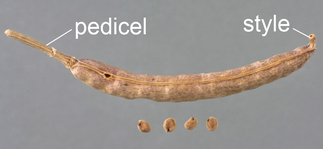 or siliclesilique:
or siliclesilique:
(includes silicle) a fruit derived from a 2-loculed, single, superior compound ovary in which the two halves of the fruit split away from a persistent partition (around the rim of which the seeds are attached) ), dehiscing longitudinally from the base to apexapex:
), dehiscing longitudinally from the base to apexapex:
the point farthest from the point of attachment, or the "tip" of an organ with two loculeslocule:
with two loculeslocule:
structurally distinct compartment with the fruit
often divided by a persistent partition, sometimes indehiscentindehiscent:
not opening on its own, as in a fruit
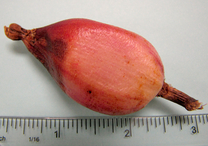 . Fruits 1–180 mm long, globoseglobose:
. Fruits 1–180 mm long, globoseglobose:
3D shape—more or less spherical to toruloseknotted:
to toruloseknotted:
3D shape—a cylindrical or ellipsoid body that is swollen and constricted at intervals; torulose , compressedcompressed:
, compressedcompressed:
flattened; in grasses, used to denote compression (not necessarily flattened) either laterally or dorsiventrally
at right angles or parallel to the septumseptum:
(pl. septa) a dividing cross wall or partition
 , quadrangularquadrangular:
, quadrangularquadrangular:
2D shape—four-sided, as in a square or rectangle , or tereteterete:
, or tereteterete:
approximately circular in cross section; width and thickness approximately equal
 in transection, often beakedbeak:
in transection, often beakedbeak:
a usually firm, terminal appendage, sometimes tapered , with one, few, or many seeds. Pericarppericarp:
, with one, few, or many seeds. Pericarppericarp:
fruit wall or fruit coat
usually brown (all shades), paperypapery:
texture—papyraceous, chartaceous; very thin, pliable, and readily torn; like paper
, woodywoody:
texture—consisting mainly of indurate lignified tissues, characteristic of or resembling wood
or corkycorky:
firm, relatively light, discontinuous but strongly cohesive, and resilient
, glabrousglabrous:
without hairs
or pubescentpubescent:
surface relief—bearing hairs
(scabrous with minute forked, stellatestellate:
star-shaped; with radiating branches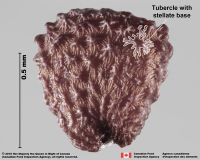 , or dendric hairs to densely covered with long silky hairs), keeledkeel:
, or dendric hairs to densely covered with long silky hairs), keeledkeel:
a longitudinal ridge, like the keel of a boat, formed by the lengthwise folding of a structure, such as a lemma or palea
 to winged. If wings present, transversely 2-, 4-, 6-, or 10-winged, sometimes apically winged. Pericarppericarp:
to winged. If wings present, transversely 2-, 4-, 6-, or 10-winged, sometimes apically winged. Pericarppericarp:
fruit wall or fruit coat
smooth or unsmooth, sometimes with hornshorn:
a straight or curved, slenderly conic or conoidal protrusion, resembling an animal horn
, crests, or spinelike projections. Seed arrangement in loculeslocule:
structurally distinct compartment with the fruit
may help in identification to genus, note if uniseriateuniseriate:
arranged in a single row; e.g. seeds arranged in a single row within a locule
, biseriatebiseriate:
arranged in two rows; e.g. seeds arranged in two rows within a locule
, or aseriate, see BrassiBase.
Seeds globoseglobose:
3D shape—more or less spherical , oblongoblong:
, oblongoblong:
2D shape—much longer than broad with nearly parallel sides, corners are rounded , ovoidovoid:
, ovoidovoid:
3D shape—ovate , or lanceoloidlanceoloid:
, or lanceoloidlanceoloid:
3D shape—lanceolate
, flattened, compressedcompressed:
flattened; in grasses, used to denote compression (not necessarily flattened) either laterally or dorsiventrally
, or tereteterete:
approximately circular in cross section; width and thickness approximately equal
 , usually 0.3–4 mm long, rarely to 18 mm. If winged, with marginalmarginal:
, usually 0.3–4 mm long, rarely to 18 mm. If winged, with marginalmarginal:
at, on, or close to the margin or border
wing or wing is confined to one or both ends. Seed coat usually black or brown, dulldull:
reflecting only a low proportion of incident light, with no apparent sheen or shinyshiny:
or shinyshiny:
uniformly reflecting a high proportion of incident light at all angles , thin or crustaceouscrustaceous:
, thin or crustaceouscrustaceous:
texture—thin, dry, indurate, and brittle
, sometimes mucilaginousmucilaginous:
resembling mucilage; moist and sticky
, sculptured or rough. Hila punctate or larger than punctatepunctate:
surface relief—dotted with pits or with translucent, sunken glands or with colored dots, similar to pitted .
.
Embryo well developed, completely filling seed coat, axileaxile:
on or of the axis
and centric, foliatefoliate:
appearing leaf-like
, bentbent:
(of embryo) embryo is bent at an acute, V-shaped angle with the ends close together and generally thick cotyledons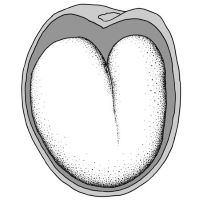 to strongly curvedcurved:
to strongly curvedcurved:
(of embryo) linear embryo is curved into an arch or horseshoe with the ends far apart or folded, rarely straight (Leavenworthia), cotyledons wider than radicleradicle:
or folded, rarely straight (Leavenworthia), cotyledons wider than radicleradicle:
the embryonic root of the embryo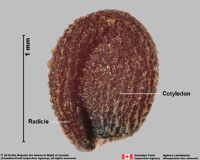 , sometimes as much as 10x wider. Cotyledonary position useful in identifying to tribe, see BrassiBase.
, sometimes as much as 10x wider. Cotyledonary position useful in identifying to tribe, see BrassiBase.
Endosperm scanty.
| Fruit | |
| Type | bivalved capsulecapsule: a dry, dehiscent fruit derived from a compound ovary  (siliquesilique: (siliquesilique:(includes silicle) a fruit derived from a 2-loculed, single, superior compound ovary in which the two halves of the fruit split away from a persistent partition (around the rim of which the seeds are attached)  or siliclesilique: or siliclesilique:(includes silicle) a fruit derived from a 2-loculed, single, superior compound ovary in which the two halves of the fruit split away from a persistent partition (around the rim of which the seeds are attached)  ), nutlike, schizocarpschizocarp: ), nutlike, schizocarpschizocarp:usually dry fruit splitting between two or more locules to form distinct, indehiscent, usually one seeded segments; fruit derived from a single, superior or inferior, compound ovary; compare to mericarp 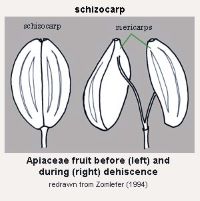 (e.g. Raphanus), samaralike (e.g. Raphanus), samaralike |
| Size range | 1–180 mm long |
| Shape(s) | globoseglobose: 3D shape—more or less spherical  , ellipsoidellipsoid: , ellipsoidellipsoid:3D shape—elliptic , fusiformfusiform: spindle-shaped; broadest at the middle and tapering at both ends 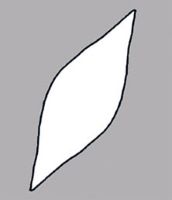 , oblongoblong: , oblongoblong:2D shape—much longer than broad with nearly parallel sides, corners are rounded  , linearlinear: , linearlinear:(shape) long, narrow, and uniform in width; (of embryo) embryo is straight and much longer than wide  , ovoidovoid: , ovoidovoid:3D shape—ovate  , lanceoloidlanceoloid: , lanceoloidlanceoloid:3D shape—lanceolate , pear-shaped, clavateclavate: 3D shape—club-shaped, with attachment at or near narrow end (compare obclavate) 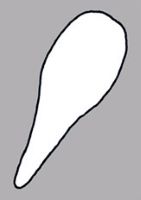 , cordiformcordiform: , cordiformcordiform:3D shape—heart-shaped , deltoid, panduriformpanduriform: 3D shape—fiddle-shaped, obovate with deep, rounded sinuses opposite one another , toruloseknotted: 3D shape—a cylindrical or ellipsoid body that is swollen and constricted at intervals; torulose  , didymousdidymous: , didymousdidymous:3D shape—paired, usually inflated and appears as two globose to ovoid halves pressed together |
| Texture | paperypapery: texture—papyraceous, chartaceous; very thin, pliable, and readily torn; like paper , woodywoody: texture—consisting mainly of indurate lignified tissues, characteristic of or resembling wood , corkycorky: firm, relatively light, discontinuous but strongly cohesive, and resilient |
| Surface relief | smooth, longitudinally ribbedribbed: surface relief—wide, prominent, linear ridges that are generally rounded and longitudinally situated on the surface  , proximately reticulately veinedveined: , proximately reticulately veinedveined:surface relief—lines that intersect in a vein pattern that is flush or slightly raised from the surface 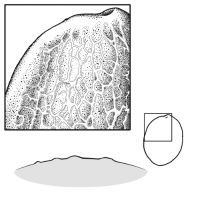 , striatestriate: , striatestriate:surface relief—having fine, parallel lines, grooves or ridges  , echinate, papillosepapillate: , echinate, papillosepapillate:surface relief—bearing minute, distinct, broad-based projections, tapering to a rounded apex  , wartywarty: , wartywarty:surface relief—distinct, rounded projections that are large relative to the fruit size; tuberculate, verrucose  , wrinkledwrinkled: , wrinkledwrinkled:surface relief—shallow, irregular folds and furrows covering the surface; appearing overall though crumpled and then spread out  , or with horn-shaped or spine-like projections; often pubescentpubescent: , or with horn-shaped or spine-like projections; often pubescentpubescent:surface relief—bearing hairs |
| Color(s) | brown (all shades), green, red, purple |
| Unique features | Usually bivalved capsulescapsule: a dry, dehiscent fruit derived from a compound ovary  , opening longitudinally from the base to apexapex: , opening longitudinally from the base to apexapex:the point farthest from the point of attachment, or the "tip" of an organ  , with few to many seeds attached to the persistent rim or replumreplum: , with few to many seeds attached to the persistent rim or replumreplum:the rim, formed by the persistent placentas, and connected by a false septum in Brassicaceae fruits. The fruit valves are attached to this rim and separate from it in dehiscent fruits. , and divided by a paperypapery: texture—papyraceous, chartaceous; very thin, pliable, and readily torn; like paper or membranousmembranous: texture—extremely thin, pliable, and fairly tough partition. Often with persistent stylestyle: in a flower, the narrow and elongated part of the pistil between the stigma and the ovary; sometimes persisting in fruit 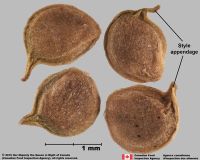 remnant and/or beakedbeak: remnant and/or beakedbeak:a usually firm, terminal appendage, sometimes tapered  . . |
| Seed | |
| Size range | usually less than 4 mm long |
| Shape(s) | globoseglobose: 3D shape—more or less spherical  , oblongoblong: , oblongoblong:2D shape—much longer than broad with nearly parallel sides, corners are rounded  , ovoidovoid: , ovoidovoid:3D shape—ovate  , lanceoloidlanceoloid: , lanceoloidlanceoloid:3D shape—lanceolate |
| Surface relief | groovedgrooved: surface relief—linear depressions that may be single or form a series of grooves over the surface 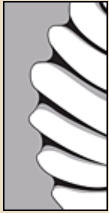 , ribbedribbed: , ribbedribbed:surface relief—wide, prominent, linear ridges that are generally rounded and longitudinally situated on the surface  , pittedpitted: , pittedpitted:surface relief—surface with small depressions in which the areas between the hollows do not take on the appearance of a true reticular net  , reticulatereticulate: , reticulatereticulate:surface relief—netted, raised walls or concave grooves forming a net-like surface pattern with flat, concave, or convex interspaces  , tuberculatetuberculate: , tuberculatetuberculate:surface relief—bearing small, warty, swelling, rounded, or variously shaped projections 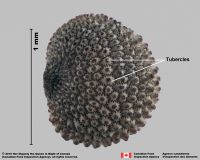 , wartywarty: , wartywarty:surface relief—distinct, rounded projections that are large relative to the fruit size; tuberculate, verrucose  , wrinkledwrinkled: , wrinkledwrinkled:surface relief—shallow, irregular folds and furrows covering the surface; appearing overall though crumpled and then spread out  |
| Color(s) | usually black, brown (all shades), yellow, or white, sometimes gray, green, or orange |
| Unique features | Small seeds of two types, globoseglobose: 3D shape—more or less spherical  with minutely reticulatereticulate: with minutely reticulatereticulate:surface relief—netted, raised walls or concave grooves forming a net-like surface pattern with flat, concave, or convex interspaces  , pittedpitted: , pittedpitted:surface relief—surface with small depressions in which the areas between the hollows do not take on the appearance of a true reticular net  , wartywarty: , wartywarty:surface relief—distinct, rounded projections that are large relative to the fruit size; tuberculate, verrucose  or wrinkledwrinkled: or wrinkledwrinkled:surface relief—shallow, irregular folds and furrows covering the surface; appearing overall though crumpled and then spread out  seed coat or flattened and orbicularorbicular: seed coat or flattened and orbicularorbicular:2D shape—circular in outline, 3D shape—globose 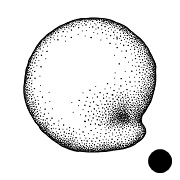 to lanceolatelanceolate: to lanceolatelanceolate:2D shape—lance-shaped; much longer than wide, with widest point below the middle, tapering to the apex (compare oblanceolate) 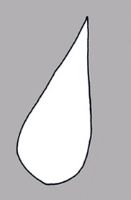 in outline, pittedpitted: in outline, pittedpitted:surface relief—surface with small depressions in which the areas between the hollows do not take on the appearance of a true reticular net  or rough seed coat, often winged, with a notched or cleft margin, and with groove or line between outwardly visible cotyledoncotyledon: or rough seed coat, often winged, with a notched or cleft margin, and with groove or line between outwardly visible cotyledoncotyledon:a primary leaf of the embryo 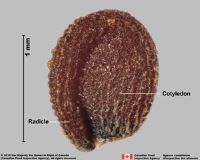 and radicleradicle: and radicleradicle:the embryonic root of the embryo  . Seeds with curvedcurved: . Seeds with curvedcurved:(of embryo) linear embryo is curved into an arch or horseshoe with the ends far apart  or folded embryos filling the seed coat, visible in the flattened seed type. Seed coat often mucilaginousmucilaginous: or folded embryos filling the seed coat, visible in the flattened seed type. Seed coat often mucilaginousmucilaginous:resembling mucilage; moist and sticky when wetted. |
| Other | |
| Embryo | well developed, completely filling seed coat, axileaxile: on or of the axis and centric, foliatefoliate: appearing leaf-like , bentbent: (of embryo) embryo is bent at an acute, V-shaped angle with the ends close together and generally thick cotyledons  to strongly curvedcurved: to strongly curvedcurved:(of embryo) linear embryo is curved into an arch or horseshoe with the ends far apart  or folded, rarely straight (Leavenworthia), cotyledons wider than radicleradicle: or folded, rarely straight (Leavenworthia), cotyledons wider than radicleradicle:the embryonic root of the embryo  , sometimes as much as 10x wider , sometimes as much as 10x wider |
| Nutritive tissue | endosperm scanty |
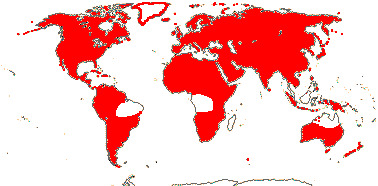
Distribution map courtesy of Angiosperm Phylogeny Website.
Flora of North America Editorial Committee 1993+Flora of North America Editorial Committee 1993+:
Flora of North America Editorial Committee, eds. 1993+. Flora of North America North of Mexico [Online]. 22+ vols. Flora of North America Association, New York and Oxford. Accessed January-March 2024. URL: http://beta.floranorthamerica.org.; Kiefer et al. 2014Kiefer et al. 2014:
Kiefer M, Schmickl R, German DA, Lysak M, Al-Shehbaz IA, Franzke A, Mummenhoff K, Stamatakis A, and Koch MA. 2014. BrassiBase: Introdcution to a novel database on Brassicaceae evolution. Plant Cell Physiology 55(1): e3, doi:10.1093/pcp/pct158.; Kirkbride et al. 2006Kirkbride et al. 2006:
Kirkbride JH, Jr, Gunn CR, and Dallwitz MJ. 2006. Family guide for fruits and seeds, vers. 1.0. Accessed September 2020-January 2022. URL: https://nt.ars-grin.gov/seedsfruits/keys/frsdfam/index.cfm .; Kubitzki et al. 1990+Kubitzki et al. 1990+:
Kubitzki K et al., eds. 1990+. The families and genera of vascular plants. 7+ vols. Berlin etc.; USDA 1980USDA 1980:
United States Dept. of Agriculture (USDA). 1980. Major weed family identification guide. Hyattsville Md, United States ; Zhengyi et al. 2004+Zhengyi et al. 2004+:
Zhengyi W, Raven PH, and Deyuan H. 2004+. Flora of China [online]. 25 vols. Science Press, Beijing China & Missouri Botanical Garden, St. Louis USA. Accessed January–March 2024. http://flora.huh.harvard.edu/china/; Zomlefer 1994Zomlefer 1994:
Zomlefer WB. 1994. Guide to Flowering Plant Families. The University of North Carolina Press, Chapel Hill. 430 pp.
*The number of genera and species is based on Christenhusz and Byng 2016Christenhusz and Byng 2016:
Christenhusz MJM and Byng JW. 2016. The number of known plant species in the world and its annual increase. Phytotaxa 261 (3): 201-217. https://doi.org/10.11646/phytotaxa.261.3.1, which may differ from the number of genera in GRIN-Global.